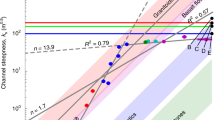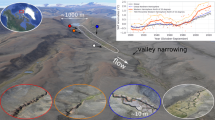Abstract
The closer channels begin to drainage divides, the greater will be the number of channels that occupy a unit area, and consequently the more finely dissected will be the landscape. Hence, a key component of channel network growth and landscape evolution theories1–7, as well as models for topographically controlled catch-ment runoff8, should be the prediction of where channels begin. Little field data exist, however, either on channel head locations9–14 or on what processes act to initiate and maintain a channel14–17. Here we report observations from several soil-mantled regions of Oregon and California, which show that the source area above the channel head decreases with increasing local valley gradient for slopes ranging from 5 to 45 degrees. Our results support a predicted relationship between source area and slope for steep humid landscapes where channel initiation is by landsliding, but they contradict theoretical predictions for channel initiation by overland flow in gentle valleys. Our data also suggest that, for the same gradient, drier regions tend to have larger source areas.
This is a preview of subscription content, access via your institution
Access options
Subscribe to this journal
Receive 51 print issues and online access
$199.00 per year
only $3.90 per issue
Buy this article
- Purchase on Springer Link
- Instant access to full article PDF
Prices may be subject to local taxes which are calculated during checkout
Similar content being viewed by others
References
Leopold, L. B. & Langbein, W. B. U.S. Geol. Surv. prof. Paper 500A (1962).
Howard, A. D. Geogr. Anal. 3, 29–50 (1971).
Abrahams, A. D. Geol. Soc. Am. Bull. 83, 1523–1530 (1972).
Kirkby, M. J. in Thresholds in Geomorphology (eds Coates, D. R. & Vitek, J. D.) 53–73 (Allen & Unwin, Boston, 1980).
Kochel, R. C., Howard, A. D. & McLean, C. in Models in Geomorphology (ed. Woldenberg, M. J.) 313–341 (Allen & Unwin, Boston, 1985).
Dunne, T. & Aubry, B. in Hillslope Processes (ed. Abrahams, A. D.) 31–53 (Allen & Unwin, Boston, 1986).
Willgoose, G. R., Bras, R. L. & Rodriguez-Iturbe, I. EOS 69, 345 (1988).
Beven, K. J. & Kirkby, M. J. Hydrol. Sci. Bull. 24(1), 43–69 (1979).
Leopold, L. B. & Miller, J. P. U.S. Geol. Surv. prof. Paper 282-A (1956).
Morisawa, M. EOS 38(1), 86–88 (1957).
Maxwell, J. C. Tech. Rep. 19, Off. Nav. Res. Proj. 389-042 (1960).
Mark, D. M. A. Ass. Am. Geogr. 73, 358–372 (1983).
Dietrich, W. E., Reneau, S. L. & Wilson, C. J. Proc. Int. Symp. Erosion Sedimentation Pacific Rim, publ. no. 165, 27–37 (Int. Ass. Hydrol. Sci., 1987).
Dietrich, W. E., Wilson, C. J. & Reneau, S. L. in Hillslope Processes (ed. Abrahams, A. D.) 361–388 (Allen & Unwin, Boston, 1986).
Horton, R. E. EOS 13, 350–361 (1932).
Kirkby, M. J. & Chorley, R. J. Bull. Int. Ass. Sci. Hydrol. 12, 5–21 (1967).
Dunne, T. & Black, R. D. Wat. Resour. Res. 6, 1296–1311 (1970).
Beaulieu, J. D. & Hughes, P. N. Bull. Oregon Dept. Geol. Min. Ind. 87 (1975).
Ruffner, T. A. Climates of the States (Gale Research Co., Detroit, 1985).
Calif. Div. Min. & Geol. Geologic Map of California Bakersfield Sheet (1964).
U.S. Geol, Surv. Topographical Instructions 1B4 (1952).
Wahrhaftig, C. in Franciscan Geology of Northern California (ed. Blake, M. C.) 31–50 (Soc. Econ. Paleontol. & Min., Los Angeles, 1984).
Rantz, S. E. U.S. Geol. Surv. HA 298 (1968).
Hack, J. T. U.S. Geol. Surv. Prof. Paper 294B (1957).
Kirkby, M. J. in Geomorphological Models (ed. Ahnert, F.) 1–14 (Cremlingen, FRG, 1987).
Iida, T. Trans. Jap. Geom. Un. 5, 1–12 (1984).
Reneau, S. L., Dietrich, W. E., Dorn, R. I., Berger, C. R. & Rubin, M. Geology 14, 655–658 (1986).
Author information
Authors and Affiliations
Rights and permissions
About this article
Cite this article
Montgomery, D., Dietrich, W. Where do channels begin?. Nature 336, 232–234 (1988). https://doi.org/10.1038/336232a0
Received:
Accepted:
Published:
Issue Date:
DOI: https://doi.org/10.1038/336232a0
This article is cited by
-
Ecohydrology 2.0
Rendiconti Lincei. Scienze Fisiche e Naturali (2022)
-
The effects of terrain factors on the drainage area threshold: comparison of principal component analysis and correlation analysis
Environmental Monitoring and Assessment (2022)
-
Morphometric Analysis of Baner, Neogal and Awa River Basins, Himachal Pradesh, India
Journal of the Geological Society of India (2022)
-
The topographic threshold of gully erosion and contributing factors
Natural Hazards (2022)
-
Initiation conditions of shallow landslides in two man-made forests and back estimation of the possible rainfall threshold
Landslides (2022)
Comments
By submitting a comment you agree to abide by our Terms and Community Guidelines. If you find something abusive or that does not comply with our terms or guidelines please flag it as inappropriate.



